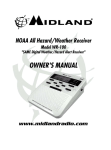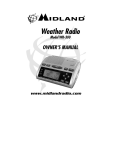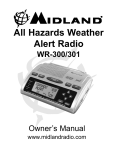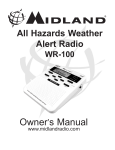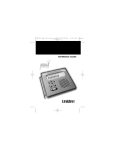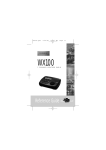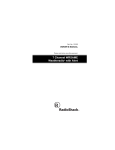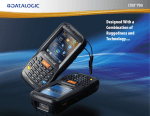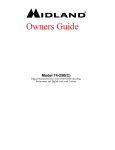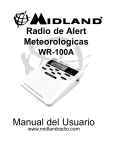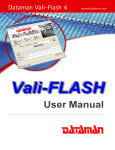Download Midland WR-100 Specifications
Transcript
The WR100 radio has been updated to have the radio respond to the weekly and monthly test with only the visual alert. During the test, the Advisory LED will light up and the "Weekly Test" or “Monthly Test” message will be visible on the display. The radio will not sound the audible alert tone to avoid giving the impression of an actual alarm. The visual response to the test is confirmation that your radio is working properly TABLE OF CONTENTS: Features.....................................................................................2 Your new MIDLAND Weather Receiver ....................................3 What is S.A.M.E?. .....................................................................3 Getting to Know Your Weather Receiver ..................................4 Quick Start Instructions .............................................................5-8 Programming Your S.A.M.E. County Code(s)...........................7-8 The National Weather Service Toll-Free Number .....................7 NOAA National Weather Radio Web Site .................................7 “ANY” S.A.M.E. County Code is Factory Default ......................7 To Program a Single S.A.M.E. County Code ............................8 To Program Multiple S.A.M.E. County Codes ...........................8 Reviewing the S.A.M.E. County Codes ....................................8 Programming Alert Type (DISPLAY, VOICE, OR TONE) .........8-9 “WEATHER/SNOOZE” button toggles between “VOICE” & “TONE” ...9 Changing the Alert Type Speed & Pattern ................................9 To Operate Weather Receiver In Silent Mode ..........................9 Reviewing Recent Alerts ...........................................................9 Start Over ..................................................................................9 Controls .....................................................................................10 Backlight of the Display .............................................................11 Icons on the Display ..................................................................11 If You Hear More Than One Channel........................................11 About NWR, NOAA, NWS & S.A.M.E. County Codes ..............12 NWR Alert Descriptions (chart) .................................................13 Testing Your Weather Receiver ...............................................14 Emergency Power .....................................................................15 Reception...................................................................................16 Troubleshooting and Help .........................................................17 S.A.M.E. County Code Record (chart) ......................................18 Service.......................................................................................19 One Year Limited Warranty .......................................................19 FCC Compliance Information ....................................................20 Specifications ............................................................................20 Glossary and Interesting Web Sites ..........................................21 http://www.midlandradio.com 1 FEATURES. x x x x x x x x x x x x x x VHF Weather Receiver ņ From seven possible National Weather Service channels for maximum reception in the 162 MHz FM band, receive 24-hour-a-day National Weather Service information (available in almost every area of the United States.) Alert Monitor System ņ Programmable for weather and hazard alerts in up to 25 counties. Receive National Weather Service S.A.M.E. warnings of dangerous weather conditions, hazards and alerts. As S.A.M.E. coded messages are received, the Weather Receiver automatically activates to warn you of dangerous weather or alert conditions. User-Selectable Warning System ņ Your choice of warning tone alarm, voice or visual displays. Weather/Snooze Button ņ large touch bar turns Weather Receiver from alert mode (standby mode) to full-time monitoring. Local Weather Information ņ Weather Receiver receives weather and alert broadcasts up to 50 miles from transmitter. Large Top-Firing Speaker ņ Directs alerts and audio toward listener. Eight-Character LCD Display ņ Liquid Crystal Display for viewing alert type. Clock ņ displays time, and has alarm and snooze functions. Emergency Powered ņ by (3) AA alkaline batteries (optional). Telescopic Antenna ņ Provides maximum range reception up to 50 miles. Antenna folds down for easy transport. Button Volume Control ņ Adjusts audio output. External Antenna Jack ņ Permits use of an (optional) extended range base antenna or a mobile antenna. External Power Jack ņ Allows use of AC adapter for everyday power. External Alert Jack ņ Allows use of other alerting devices. http://www.midlandradio.com 2 Your new MIDLAND All Hazard/Weather Receiver Model WR-100 is the latest advance in weather and alert monitoring technology, providing you with the information you need for your greatest safety from weather and other hazards. The MIDLAND All Hazard/Weather Receiver tunes into the 24/7 broadcast issued by the National Weather Service. The combined All Hazard/Weather Alert broadcast network is the most immediate source for comprehensive weather and emergency information available instantaneously to the public, in advance of TV and monitor bulletins. This MIDLAND All Hazard/Weather Alert Receiver has an innovative automatic alert system. In the event of special warning broadcasts, the monitor is automatically activated along with a loud tone, an LED light and an “alert” message on the LCD. Emergency weather bulletins include alerts about tornadoes, hurricanes, floods, ice/snow storms and other severe weather. Other emergencies might include Amber Alerts, explosions, fires or hazardous chemical spills. We encourage you to read this Owner’s Manual thoroughly before operating this unit. This manual is a valuable part of your new MIDLAND All Hazard/Weather Alert Receiver. See the “Quick Start Instructions” section of this manual for the initial Weather Receiver setup and programming. After this weather receiver is programmed and operating properly, store the manual in a safe place. What is S.A.M.E.? Specific Area Message Encoding- S.A.M.E. - Is a feature in MIDLAND Weather Radios that allows you to program in your county code or counties codes. This will eliminate any Alerts that are not within your programmed Specific Area. For example, if you only want to be informed for alerts within your county just program in your county code. But, if you want to be informed about counties that are North, South, East and West of you, you can do so. http://www.midlandradio.com 3 GETTING TO KNOW YOUR WEATHER RECEIVER: 1. 2. 3. 4. 5. 6. 7. 8. 9. WEATHER/SNOOZE alert, warning tone, & 9 minute snooze button (Weather/Hazard Standby Mode) WEATHER RECEIVER ON/OFF switch Volume (UP & DOWN) buttons “WARNING” Alert Status LightņRed “WATCH” Alert Status LightņYellow “STATEMENT” Alert Status LightņGreen MENU (programming) activate menu mode button SELECT (programming) select menu option button Arrow (programming) buttons – directional arrows (up, down, right & left) Note: This unit programs with menus similar to a TV remote control or cell phone. Features located on back and side of unit are not shown: ANT. (antenna jack), jack for optional external alert and DC JACK (also for AC Power Adapter). http://www.midlandradio.com 4 QUICK START INSTRUCTIONS. 1. SWITCH - Turn the Weather Radio Switch to ON 2. BATTERIES - Install 3 AA Alkaline batteries (not supplied) 3. AC POWER ADAPTER - Plug the AC Adapter into a standard power outlet. Plug AC Power Adapter into DC jack on back of the Weather Receiver. 4. ANTENNA - Position telescoping antenna vertical and extend to its full length above the Weather Receiver. 5. PROGRAM THE CLOCK TIME. A. Press “MENU” button to open menu options on the LCD Display. On the display you will see “TIME” B. Press “SELECT” button (hour option will begin flashing.) C. Press “UP” arrow until current hour is displayed. Note: AM /PM (on the right) changes as you scroll through hours. D. Press “RIGHT” arrow to save current hour and advance to minute settings. Program minutes the same way. E. Press “SELECT” to store the current time. F. Press “MENU” until menu is closed and current time is displayed. 6. PROGRAM ALARM CLOCK. A. Press “MENU” button to open programming menu options. B. Press “UP” arrow to scroll through menu, until “ALARM” is displayed, then press “SELECT” button. Press “UP” arrow to display “ON”. C. Press “SELECT” to select “ON” and automatically advance to alarm time options (alarm hour option will begin flashing.) D. Press “UP” or “DOWN” arrows until the alarm hour you want is displayed. Note AM./PM (on the right) change as you scroll through the hours. E. Press “RIGHT” arrow to save alarm hour and advance to alarm minutes. Program alarm minutes in the same way. F. Press “SELECT” to store the alarm time. The display will show “ON” and the alarm icon will be displayed. G. Press “MENU” repeatedly to close menu mode. (Current time will be displayed.) http://www.midlandradio.com 5 Silence Alarm Clock - by pressing any button except WEATHER/SNOOZE.” TURN OFF ALARM CLOCK by pressing “MENU”, “UP” arrow, “SELECT”, “UP” arrow, “SELECT”, and then press “MENU” repeatedly to display current time. 7. VOLUME ADJUSTMENT. A. When the Weather Receiver is turned on, “NOAA” will appear on the display. B. Press “WEATHER/SNOOZE” button; “WEATHER” will appear on the display. C. Press “UP” (or “DOWN”) button to select volume. (Note: 4 ) volume bars at top right corner of display. 8. PROGRAM THE WEATHER/HAZARD CH. FOR YOUR AREA. A. B. D. E. Press “MENU” Press “UP” directional arrow until “CHANNEL” is displayed. Press “SELECT”. Press up directional arrow until you hear a clear broadcast signal of your station. Press “SELECT”. F. Press “MENU” to close menu mode. To turn Weather/Hazard broadcast on again, press “WEATHER/SNOOZE”. Note you will hear only static on the channels not received in your area. (FYI — channels are listed 1-7 on the left, and corresponding frequency numbers are displayed on the right side of display.) AT THIS POINT YOU WILL RECEIVE WEATHER AND HAZARD ALERTS ISSUED BY THE NWS. http://www.midlandradio.com 6 9. PROGRAMMING S.A.M.E. COUNTY CODE(S). Note: In addition to your own county code, you may wish to obtain the S.A.M.E. county code(s) for other counties close to you. The S.A.M.E. County Code(s) you program into your Weather Receiver will determine which counties your Weather Receiver will respond to. (The counties must be within the ± 50-mile broadcast coverage area of your local NWS.) A. First, to determine the S.A.M.E. county code(s) for counties in which you are interested: (1) call the toll-free NWS telephone number, (2) access NOAA Web Site at: www.nws.noaa.gov/nwr/indexnw.htm. 1. The National Weather Service Toll-Free Number provides S.A.M.E. County Codes at: 1-888-NWS-SAME. or (1-888-697-7263) 2. The NOAA Weather Radio Web Site provides S.A.M.E. County Codes at: www.nws.noaa.gov/nwr/indexnw.htm. Note Internet access is available free of charge at many public libraries in the United States. B. Then, when you have the S.A.M.E. County Code(s) you want to, program them into your Weather Receiver as follows. Note all empty memory locations will be indicated as “-- -- -- -- -- --” on the Weather Receiver display. 1. Turn off Weather Receiver for silent programming. 2. Press “MENU” button to open menu options. 3. Press “UP” arrow to scroll through menu options until “S.A.M.E. SET” is displayed, then press “SELECT” button. 4. Press “UP” arrow to scroll through: “SINGLE”, “MULTIPLE”, or “ANY.” (You will need to choose whether to enter a Single or Multiple S.A.M.E. County Code, or accept Any S.A.M.E. County Codes.) “ANY” S.A.M.E. County Codes is the Default Factory Setting. Your Weather Receiver comes preprogrammed to receive NWS Weather and Hazard Alert transmissions for any and all S.A.M.E. county codes within range. If you want to receive all Weather and Hazard Alert transmissions within reception range, leave your Weather Receiver set to “ANY.” http://www.midlandradio.com 7 To Program a Single S.A.M.E. County Code on your Weather Receiver: • Display “SINGLE” as explained in 1-4 above, then press “SELECT.” “S.A.M.E. 01” will be displayed. (Note if you are programming a single S.A.M.E. County Code, only the “01” setting will be used.) • Press “Select”. Using the “UP” arrow, find the first digit of your S.A.M.E. County Code. Press “RIGHT” arrow to save the digit and automatically advance to the next digit. • Program all digits of your S.A.M.E. County Code in the same way. • Press “SELECT” to store your S.A.M.E. County Code. Press “MENU” to close the programming menu. To Program Multiple S.A.M.E. County codes on your Weather Receiver: Select “MULTIPLE” to enter more than one S.A.M.E. County Code. • Display “MULTIPLE” as explained in 1-4 above, then press “SELECT.” “S.A.M.E. 01” will be displayed, indicating you will be programming your first S.A.M.E. County Code at Weather Receiver menu location “01.” • After programming your first S.A.M.E. County Code, press “SELECT” then the “UP” arrow to advance to “S.A.M.E. 02.” Program all of your S.A.M.E. County Codes in the same way. Reviewing the S.A.M.E. County Codes that you have programmed: To review the S.A.M.E. County Codes that you have programmed into your Weather Receiver, press “MENU” to open the programming menu and follow the same sequence that you used to program them. (See the section in this manual “Programming Your S.A.M.E. County Codes.) PROGRAMMING ALERT TYPE (DISPLAY, VOICE, OR TONE). 1. Turn off Weather Receiver for silent programming. 2. Press “MENU” button to open menu options. 3. Press “UP” arrow to scroll through menu options until “ALT TYPE” (Alert Type) is displayed, then press “SELECT” button. 4. Press “UP” arrow to scroll through the following (3) alert types: “DISPLAY”, “VOICE”, or “TONE”. http://www.midlandradio.com 8 Alert Type “DISPLAY” “VOICE” “TONE” Icon Description of Tone Pattern (no icon) text alert scrolls on display The alert will sound for about 8 seconds, then you will hear the voice of the weather broadcast for about 5 minutes. If you want to listen longer, press the “WEATHER/SNOOZE” button. Alert tones will sound for five minutes, or until you press any button —except the “WEATHER/SNOOZE” button which toggles to voice weather broadcast. 5. Press “SELECT” to choose the Alert Type you want. 6. Press “MENU” to exit menu programming mode. To Operate Weather Receiver in Silent Mode, select “DISPLAY ALERT TYPE”. This will turn off both the broadcast voice and audio alerts, leaving only the text message and Alert Status Lights to indicate the event. REVIEWING RECENT WEATHER/HAZARD ALERTS. The Weather Receiver can store up to 10 different Weather/Hazard alerts (with overlapping effective times) in its memory. If the Weather Receiver receives a new alert while any previous alert is still in effect, it automatically displays the new alert. You can review all alerts still in effect by pressing the “UP” arrow to scroll through the Weather Receiver’s active alert memory. A Double Beep indicates the end of the list. “NO MESSAGE” will be displayed if no alerts are active. Start Over. If you want to start over while programming menus, press “MENU” button enough times to close the menu options until you return to your starting point. Press “MENU” to exit or “back out” of programming mode. If no program buttons are pressed for about one minute the Weather Receiver will exit the menu mode. http://www.midlandradio.com 9 CONTROLS: 1. WEATHER/SNOOZE alert, warning tones & 9 minute snooze button. Press this button to put the weather/hazard receiver into standby mode (alert monitor mode.) Press button again to return to hearing National Weather Service weather/hazard voice reports. - Press this button to cancel alert warning tones and any external alert features when alert is active. 2. WEATHER SWITCH ON/OFF. Main power switch for Weather Radio, turns it on & off. (Only the clock is active when this switch is off.) 3. Volume (UP & DOWN) buttons. Switch Weather Receiver on, then press these buttons to adjust to desired listening level. 4. “WARNING” Alert Status light ņ Red. Indicates that the National Weather Service has issued a warning for your area. 5. “WATCH” Alert Status Light ņ Yellow. Indicates that the National Weather Service has issued a watch for your area. 6. “STATEMENT” Alert Status Light ņ Indicates a S.A.M.E. statement has been issued for your area by the National Weather Service. 7. MENU button. Press to activate programming mode. (Use directional arrows to move through programming menu options.) 8. SELECT (programming) button. Press this button to enter the selected menu mode. Press this button to confirm your menu option selection. 9. Arrow buttons – directional arrows (up, down, right & left.) Use directional arrows to move through the Weather Receiver program menus. Note you can also use the arrow buttons to review previous alerts when in normal display mode. http://www.midlandradio.com 10 BACKLIGHT OF THE DISPLAY. Pressing and releasing a button will turn on the backlight of the Weather Receiver display for about 5 seconds. ICONS ON THE DISPLAY. The following icons appear on the Weather Receiver display to indicate the monitor functions that are active. ICON DESCRIPTION Volume Bars Clock Alarm Voice Alert Warning Tone Alert Low Battery NOAA Monitor On IF YOU HEAR MORE THAN ONE CHANNEL. When you program the Weather/Hazard channel, you may hear weather and hazard alerts on more than one channel. This means that your are receiving broadcast from more than one National Weather Service station in your area. Simply choose the one that sounds clearest. Channels preset on Broadcast Frequency Weather Receiver (MHz) 1 162.400 2 162.425 3 162.450 4 162.475 5 162.500 6 162.525 7 162.550 You can find more information on weather frequency channels on the NOAA Web Site at www.nws.noaa.gov/nwr/indexnw.htm. http://www.midlandradio.com 11 About NWR, NOAA, NWS, & S.A.M.E. County Codes. National Weather Radio (NWR) is a service of the National Oceanic and Atmospheric Administration (NOAA.) As the "Voice of the National Weather Service", NWR is a continuous broadcast of the latest weather and hazard alert information from your local National Weather Service (NWS) office. It is in operation 24 hours a day, 7 days a week. In 1994, NOAA began broadcasting coded emergency signals that identify the specific geographic area (such as the county within a state) that is affected by an emergency. Until that time, such specific emergency weather information was sent in other ways to broadcast stations and others and then relayed to the public. NOAA transmits the coded emergency signals using a technique called Specific Area Message Encoding (S.A.M.E..) The MIDLAND Weather Radio (Model WR-100 ) is designed to receive these S.A.M.E. county code transmissions. NWR divides the United States and territories by state and county (or parish) and assigns a six-digit code number called a FIPS (Federal Information Processing System) code, also known as a NWR/S.A.M.E. county code. You can program the Weather Receiver with up to 25 S.A.M.E. County Codes. The Weather Receiver allows you to receive broadcast alerts for either your own county or for up to 25 counties. You do this by programming in the S.A.M.E. county codes for counties important to you. This will eliminate any Alerts that are not within your area of interest. For example, if you only want to be informed for alerts within your own county just program in the S.A.M.E. county code for your own county. But, if you want to be informed about counties that are North, South, East and/or West of you, you will also program in those S.A.M.E. county codes. When you program your S.A.M.E. country code(s) into the MIDLAND Weather Receiver, you eliminate any Alerts that are not within those counties. Warnings, watches and statements of weather and other area emergencies ņ about 50 different types ņ will activate the Weather Receiver for only your programmed specific area. The S.A.M.E. message the NWR sends contains information that tells the weather receiver the time period for which the alert is valid. NWS can set the active time of the alert from 15 minutes to up to 6 hours. When the designated time has passed, the Weather Receiver display message and light will automatically reset to their normal state. http://www.midlandradio.com 12 NWR Alert Descriptions What You See On Weather Receiver Display Alert Warning Tone TORNADO WATCH TORNADO WARNING SEVERE THUNDERSTORM WATCH SEVERE THUNDERSTORM WARNING FLASH FLOOD WATCH FLASH FLOOD WARNING FLOOD WATCH FLOOD WARNING WINTER STORM WATCH WINTER STORM WARNING BLIZZARD WARNING HIGH WIND WATCH HIGH WIND WARNING DUST STORM WARNING HURRICANE WATCH HURRICANE WARNING TROPICAL STORM WARNING TROPICAL STORM WATCH COASTAL FLOOD WATCH COASTAL FLOOD WARNING SPECIAL MARINE WARNING AVALANCH WATCH AVALANCH WARNING VOLCANO WARNING EARTHQUAKE WARNING EVACUATION IMMEDIATE TSUNAMI WATCH TSUNAMI WARNING SHELTER IN PLACE WARNING CIVIL DANGER WARNING CIVIL EMERGENCY MESSAGE RADIATION HAZARD WARNING MATERIAL HAZARD WARNING NUCLEAR POWERPLANT WARNING LAW ENFORCEMENT WARNING FIRE WARNING CHILD ABDUCTION EMERGENCY 911 TELEPHONE OUTAGE EMERGENCY TUNE TV WATCH TUNE TV WARNING LOCAL AREA EMERGNCY EMERGENCY ACTION NOTIFICATION EMERGENCY ACTION TERMINATION SEVERE WEATHER STATEMENT SPECIAL WEATHER STATEMENT FLASH FLOOD STATEMENT FLOOD STATEMENT HURRICANE STATEMENT Fast tone Very fast tone Fast tone Very fast tone Fast tone Very fast tone Fast tone Very fast tone Fast tone Very fast tone Very fast tone Fast tone Very fast tone Very fast tone Fast tone Very fast tone Very fast tone Fast tone Fast tone Very fast tone Very fast tone Fast tone Very fast tone Very fast tone Very fast tone Very fast tone Fast tone Very fast tone Very fast tone Very fast tone Very fast tone Very fast tone Very fast tone Very fast tone Very fast tone Very fast tone Fast tone Fast tone Fast tone Very fast tone Very fast tone Low tone Low tone Low tone Low tone Low tone Low tone Low tone http://www.midlandradio.com 13 TESTING YOUR WEATHER RECEIVER WITH TEST SIGNALS BROADCAST BY NWS. All National Weather Service stations periodically transmit test signals. Some stations broadcast a test signal only once a week, while others test more often. NWS also may broadcast System Demonstrations. You can find out when your local NWS station broadcasts test signals by calling the NOAA National Weather Service Forecast Office (listed under ‘Weather” in the Federal Government section of the telephone book.) During the weekly test signal, the local NWS station will give a list of counties covered by their transmitter. The NWS test signal allows everyone with Weather Receiver receivers to verify the operation of their equipment. The following test signals may be sent by the NWS during testing: What You See On Display REQUIRED WEEKLY TEST What You Hear Voice announcement intermittent beeps REQUIRED MONTHLY TEST Same as above SYSTEM DEMO Same as above NATIONAL PERIODIC TEST Same as above As the NWS adds new test capabilities, your Weather Receiver is set to receive them and alert you automatically with no modifications. Connecting the External Alert Output to an External Device You may need to turn on or turn off another device when an alert is received. The WR-100 provides a switch closure to signal other devices at the EXT. ALERT jack when the monitor receives an alert. The output is compatible with home automation devices from suppliers like X-10 and others. Connect the positive lead of the interface to the tip of the 1/8 inch (3.5mm) phone plug and the negative lead to the body of the plug. http://www.midlandradio.com 14 A DC powered device using 12 Volts or less and requiring less than 200mA of current can be switched directly using the EXT. ALERT jack. Observe the polarity of the jack so that the negative side of the external power source is connected to the body of the 1/8 inch (3.5mm) phone plug and the device is connected to the positive source and to the tip of the phone plug. The internal switch is closed when an alert is received. Pressing any button on the front of the monitor will open the switch. EMERGENCY POWER. See “Quick Start Instructions” for battery installation. Connecting Power. The AC power adapter is recommended for normal operation if the Weather Receiver is to be in service for more than a few hours. Backup Batteries are also recommended during normal operation. The condition of the batteries is monitored by the Weather Receiver. When the “Low Battery” icon flashes on the display, the battery has been discharged and should be replaced. Do not leave a dead or weak battery in the monitor. Do not leave a battery in the monitor when it is not in use. The battery may leak and possibly damage your Weather Receiver. Dispose of batteries properly. Your MIDLAND Weather Receiver can be emergency powered by (3) AA alkaline batteries. In an emergency situation, (3) AA alkaline batteries should provide approximately 24 hours of continuous operation. The clock will run for at least 10 days on batteries when the monitor is turned off with the MONITOR ON / OFF control. http://www.midlandradio.com 15 RECEPTION. A System of Weather/Hazard Alert Broadcasts in the United States. (NOAA) The National Weather Service operates National Weather Radio as a system of weather and hazard alert broadcasts covering a large area of the United States. Only a few areas are not included. Currently, NOAA Weather Radio is directly available to 93% to 95% of the U.S. population. Typical weather/hazard broadcast (162MHz) monitor reception distance will range from 25-50 miles. Your MIDLAND Weather Receiver can receive broadcasts from the Weather Stations up to 50 miles away depending on your location and conditions of weather, terrain, etc. If reception in your area is not good, try different locations in your home or office to find a place of good reception. A location near a window is a good starting place. If A Weather Station Cannot Be Heard on any channel, contact your local National Weather Service office to verify that the station is on the air. Also verify the CHANNEL (frequency) they broadcast and the location of the weather station. If your local Weather Service is transmitting and you are not receiving the broadcasts, you may need an external antenna. External Antenna can be used for better reception from greater distances. To use an external (outdoor) antenna, you must have an antenna with an RCA phono plug or an adapter to plug the antenna into the back of the WEATHER RECEIVER. One suggested antenna is the MIDLAND 18-259W VHF Through-Glass Antenna. This antenna improves reception when applied to either single-pane windows or double-pane windows. Metal Structure (some mobile homes) Reception is difficult because the metallic structure impedes the transmission of monitor waves. Place your Weather Receiver near a window. If this doesn't provide reasonable reception, an external antenna must be used. http://www.midlandradio.com 16 TROUBLESHOOTING Problem No power Suggestion Is AC Power Adapter securely plugged into both DC jacks on back of Weather Receiver and to wall outlet? If AC power has failed, are batteries installed? Are dead batteries in the unit? Unplug power, remove and replace batteries. No sound. No weather broadcast when you press WEATHER/SNOOZE button Check VOLUME. Ensure that telescoping antenna is up and fully extended. The monitor is not responding properly to NWS weather alert broadcasts If you are using an external antenna, ensure that it is connected properly. Ensure that the monitor is set to the NOAA weather channel in use in your area. Contact NOAA to ensure they are presently broadcasting. Check to see that you have programmed in the correct S.A.M.E. County Code(s). For HELP, contact Midland Radio Corporation 1120 Clay Street North Kansas City, Missouri 64116 Phone: (816) 241-8500 Fax: (816) 241-5713 E-mail: [email protected] URL: www.midlandradio.com http://www.midlandradio.com 17 S.A.M.E. County Code Record. Use this space to keep a record of the S.A.M.E. county codes that you program into your MIDLAND Weather Receiver. County Name S.A.M.E. County Code NWR Channel* *Note if you have reason to switch between different Weather Receiver channels, you may also wish to record the channel used for a particular county NWR frequency. http://www.midlandradio.com 18 SERVICE. If your MIDLAND Weather Receiver fails to operate properly, check the “Troubleshooting” section in this manual before returning it for service. If necessary, return as follows: 1. Pack the unit in its original box and packing. 2. Include the following: a. Full description of any problems b. Money order for $20.50 to cover shipping and handling c. Daytime telephone number, name & address 3. For warranty service include a photocopy of the receipt showing the date of sale. 4. You do not need to return accessory items (AC/DC Adapter, batteries) unless they might be directly related to the problem. 5. A flat rate of $45.00 will apply to repairs not covered by warranty or units that are over one year old. Send only cashiers check, money order or Master Card or Visa card number. ONE YEAR LIMITED WARRANTY. MIDLAND Radio Corporation will repair or replace, at its option without charge, your WR-100 weather alert monitor which fails due to a defect in material or workmanship within one year following the initial consumer purchase. This warranty does not include any antennas, which may be a part of or included with the warranted product, or the cost of labor for removal or re-installation of the product in a vehicle or other mounting. Performance of any obligation under this warranty may be obtained by returning the warranted product, freight prepaid, along with a copy of the original sales receipt to MIDLAND Radio Corporation at the address provided below. This warranty gives you specific legal rights, and you may also have other rights, which vary, from state to state. Note: The above warranty applies only to merchandise purchased in the United States of America or any of the territories or possessions thereof, or from a U.S. Military exchange. For warranty coverage on merchandise purchased elsewhere ask your dealer. http://www.midlandradio.com 19 Please send your Weather Radio To: Midland Radio Corporation Warranty Service Department 1120 Clay Street North Kansas City, Missouri 64116 Phone: (816) 241-8500 Fax: (816) 241-5713 E-mail: [email protected] URL: www.midlandradio.com FCC COMPLIANCE INFORMATION. MIDLAND (NOAA) Weather Receiver Model WR-100, “S.A.M.E. Digital Weather/Hazard Alert Receiver” This device complies with part 15 of the FCC Rules. Operation is subject to the following two conditions: (1) This device may not cause harmful interference; (2) This device must accept any interference received including interference that may cause undesired operation. SPECIFICATIONS. Specifications are nominal and subject to change. General Frequency Range (162.4O, 162.425, 162.45, 162.475, 162.50, 162.525, 162.55MHz) Number of WX Channels..................................... 7 Input Voltage ....................................................... 9-14 Volts DC Dimensions 130MM W x 50MM H x 152MM D (51/2 x 2 x 6 in.) Receiver 20 dB Quieting Sensitivity.................................... 0.5 uV FIPS County code Sensitivity at5kHz Dev .......... 0.5uV Channel Selectivity .............................................. ±25kHz, 60dB Speaker Impedance ............................................ 8 ohms Speaker Output at10%THD................................. 200 mW max. http://www.midlandradio.com 20 GLOSSARY & Interesting Web Sites: FCC ...................Federal Communications Commission Agency charged with regulating interstate and international communications by monitor, television, wire, satellite and cable. www.fcc.gov FIPS...................U.S. Department of Commerce, Bureau of the Census, Geography Division provides the Federal Information Processing Standard (FIPS). FIPS are the names and (S.A.M.E.) county codes that represent the counties and other entities treated as equivalent legal and/or statistical subdivisions of the 50 States, the District of Columbia, and the possessions and freely associated areas of the U.S. For more information, log on to: http://www.itl.nist.gov/fipspubs/index.htm LCD....................Liquid Crystal Display. (The monitor display is an LCD.) LED....................Light Emitting Diode. (The 3 indicator lights are LEDs.) NOAA.................National Oceanic and Atmospheric Administration. Environmental data services, and provides a reference library for students, teachers, and researchers. www.noaa.gov NWR ..................National Weather Radio. Nationwide network of monitor stations broadcasting continuous weather information. Lists stations and coverage, explains how to get a receiver. www.nws.noaa.gov/nwr NWS ..................National Weather Service. Current weather conditions, forecasts, warnings, and weather safety. Offers maps, radar and satellite images, numerical models, and educational resources. www.nws.noaa.gov S.A.M.E..............Specific Area Message Encoding is a special monitor signal included now with National Weather Service weather and alert broadcasts to pinpoint alert areas. Find out more at www.nws.noaa.gov/nwr/indexnw.htm. Toggle................Switch back and forth between two functions or options. WX channels .....Weather channels. http://www.midlandradio.com 21 Midland Radio Corporation 1120 Clay Street Kansas City, MO 64116 Tel: 816.241.8500 Fax: 816.241.5713 http://www.midlandradio.com http://www.midlandradio.com 22
























